| |
A
Matter of Time - Collecting Antique Pocket Watches
Story by Mike McLeod

Note: For questions about pocket watches, contact: www.antique-pocket-watch.com,
www.pocketwatcher.org
or www.antiquewatchco.com.
Although time keeping mechanisms have been
around for thousands of years, the first mobile clocks did not appear until the 1500s.
Until that time, a clock's mechanism was so large, heavy and ponderous, few people
considered the possibility of a portable clock.
Most clocks were huge and resided in
churches or cathedrals. Counterbalances and weights to power clocks were usually made of
stone blocks or metal. In the 1500s, Henry De Vick invented a clock for the royal palace
in Paris with a 500-pound. weight that traveled 32 feet - and it only had an hour hand (as
did all clocks in those days). A hand-held timepiece was a ridiculous thought at that
time.
Inventing the portable clock would bring
great advances to civilization. It was needed for the study of astronomy, physics, and for
ship captains to calculate location - increasing the likelihood of the safe return of a
ship, its cargo, and crew.
Although the Egyptians first used the
sundial by 1300 B.C, German locksmith Peter Henlein is one of the first recorded inventors
to create a watch in the 1500s.
The first watches were made of steel . The
first watch-makers were locksmiths and blacksmiths because those guilds worked steel to
make tools and implements. Eventually locksmiths dominated the trade as brass, silver and
gold were used to replace steel. Also "miniaturization" slowly swept the trade,
and locksmiths were more adept at the fine work required. At this time watches were
typically four or five inches wide and about three inches thick.
It was the discovery of spring technology
by Peter Henlein and others that made the personal timepiece possible. Spiral springs
could be wound and uncoiled to move the hour hand of the clock. Although the technology
was a great leap forward from hanging weights, it was still highly inaccurate because
coiled springs don't unwind at a constant speed. But in comparison to judging the hour by
the sun, having a timepiece you can carry or wear on a necklace - even though it was off
by an hour or so - was close to a miracle.
The first solution to uneven unwinding came
when watchmakers realized the spring uncoiled at a more constant pace when it was not
wound tightly. Various means of preventing this were invented: the stackfreed was a cam
with an additional spring that compensated for the main spring's changes in speed, and the
fusee was a stop that prevented the spring from being wound too tightly. It was usually
made of stiff hog bristle.
In 1675 several watchmakers discovered that
a spiral spring attached to the balance greatly increased accuracy. Suddenly, watches
reflected the correct time within minutes rather than being off by close to an hour. This
heralded the addition of the minute hand.
Up until about this time, watches had to be
wound twice a day. A fourth wheel added to the movement decreased the winding required to
once per day.
A hand to measure seconds was added a
little less than a century later. As years passed, the customer's appetite for more and
more gadgets on pocket watches led to the addition of calendars (marking the day, date and
month), phases of the moon, alarms, chimes and music.
Early pocket watches had no covering to
protect the face or the hour hand. In the 1700s English watchmakers began creating gold
and silver pair cases to slide the watch into for safe keeping. The manufacturer's name or
mark is usually found on a pair case. If it doesn't match the name on the watch, then the
pair case is not the original, but a replacement. Glass crystals were added to protect the
dial but because they were translucent, they still had to be removed to read the time.
English watchmakers added jewels
(gemstones) in the 1700s as bearings in the watches to prevent friction and wear between
metal parts. This helped catapult them to the industry forefront. Remarkably, watchmakers
from other countries did not adopt "jeweling" for nearly a century. Today, the
number of jewels a watch has is a sign of its quality and durability.
Finding a pocket watch made prior to 1700
is rare these days. Most in existence reside in large collections. Antique watches crafted
before 1865 are very popular. They are sought by collectors and Civil War buffs and
re-enactors, says Eric Engh, co-owner of the website www.oldwatch.com, the world's largest
seller of pocket watches on the internet.
"Walthams, in particular, are very
collectible," he said. "They were the first mass produced watches with
interchangeable parts. But because of the evolution of their watch designs in the early
years, they sometimes made very few of some models. This is why they are in high
demand."
Engh recently sold an 18-carat gold, size
20, Waltham Model Appleton Tracy with key wind from the rear for $10,000.
"Less than 350 of this model are known
to exist," Engh explained.
Engh reports that the internet is
influencing demand for American-made watches. In the past, European and Asian countries
didn't appreciate the craftsmanship of American watches, but during the last 18 months,
he's seen more American timepieces going overseas. He attributes it to the information
available on the internet.
Determining the age of an antique pocket
watch is a matter of finding a good reference guide and checking the manufacturer's serial
number. (Most information is available on the internet.) The serial number on an American
watch is on the movement inside the watch, not on the watch face or the casing. Older
English watches have hallmarks that can be researched to find the manufacturing date.
Antique watches made on the continent in Europe are more difficult to date. Sometimes they
have serial numbers, but often don't. Patent numbers can be used for dating. Be aware that
the name on a watch's face is not necessarily the name of the manufacturer. Watch
manufacturers often printed a company's name on the dial in return for ordering a specific
number. Mail order and distribution companies did the same thing.
A good reference guide for dating and
valuing an antique watch is American Watches - Beginning To End, ID and Price Guide
(Meggers & Ehrhardt, Heart of America Press, ISBN: 0-913902-53-5, $35, 352-669-4791,
www.hoapress.com). Another good reference book is the Complete Price Guide to Watches
(20th edition by Cooksey Shugart, et al, $26.95 at Amazon.com).
What determines the value of a watch? As
with all collectibles, it's what the buyer is willing to pay. Michael Roesch
(mroesch@bellsouth.net), a collector of antique watches, recommends the key points listed
on the continuation page.
The Studebaker
Pocket watch collecting offers many
sub-categories to embark on. Some Notre Dame fans and Studebaker car fans are avid
collectors of the Studebaker watch, made in South Bend, Indiana, by the same company that
made the cars. (Today, the company is called South Bend.)
Eric Engh can't keep a Studebaker on his
website for more than 48 hours before it sells, he says. Generally, Studebakers sell in
the neighborhood of $1,200 to $1,500, and the price keeps going up. One reason: There are
only about 3,000 in existence.
Engh cautions the novice about the
difference between THE Studebaker and a Studebaker. Southbend printed Studebaker on
the faces of many watches. Even though most people shy away from opening the case for fear
of harming the watch, inside is where you can make sure. The words The Studebaker are on
the movement of the genuine article. If it says, Studebaker or South Bend, it isn't The
Studebaker, and is worth considerably less. "Plain" Studebakers are good
watches, but they are worth usually in the neighborhood of $495. Don't get caught paying
The Studebaker price for a Studebaker.
Railroad Watches
Another area for pocket watch collectors is
Railroad watches. On April 19, 1891, a train engineer's watch stopped for four minutes and
then started again. This temporary mechanical failure resulted in a train wreck that
caused nine casualties in Kipton, Ohio. A commission was set up to create new standards
for pocket watches used by all railroads. Standards included having at least 15 jewels
(after 1886, the amount steadily increased afterwards); being accurate within 30 seconds
per week; having a white face (but silvered faces were allowed until the second decade of
the 20th century); black Arabic numbers each minute delineated; size 16 or 18; adjusted to
five positions; and temperature compensated. (Canadian RR watches, on the other hand, had
Roman numerals and an inner ring of Arabic numerals from 13-24 for the p.m. hours.) The
rules were sometimes broken so you can still find a RR watch with Roman numerals. The last
two requirements were critical. As the early watchmakers discovered, not only would cold
and heat cause the movement to slow or speed up, but so did the watch's position. Imagine
trying to carry a watch in one position all the time, especially while working on a train.
Railroad watches had to stand up to constant abuse from the jarring and swaying of early
trains. Engineers were required to have their watches inspected regularly and to submit a
certificate stating its reliability to supervisors.
The picturesque movie scene of a train
conductor looking at his watch and shouting, "All aboard!" does not reflect the
true importance of a train staying on schedule. When there was only one track for trains
barreling in both directions, being on time was a matter of life and death. As the Kipton
wreck proved, an engineer's pocket watch being off by as little as four minutes could mean
disaster.
In watch descriptions, a size is usually
listed from 0 to 23. There are also key sizes for watches wound with keys. A watch's size
is not the width or length of the watch or casing. It's actually a standard measurement
for the size of the movement. To meet railroad requirements, a watch's movement must be a
size 16 (1 7/10 inches) or a size 18 (1 23/30inches).
Railroad watches are particularly appealing
to collectors for several reasons, even though the faces are very plain. The quality of
Railroad watches was very high, second only to chronometers. Railroad watches were not
produced in the same quantities as everyday pocket watches, even though quite a few
companies made them. The ephemeral "romance of the railroad" adds to its value.
Young and old are captured by the spirit of the rails, and that same feeling inspires
collectors of Railroad watches. Amazingly Railroad watches are quite affordable. A typical
watch in fine condition sells for between $300 and $600. The cost has accelerated in the
last 24 to 36 months, according to Eric Engh, due to demand from Asian and European
collectors.
For collectors, Waltham and Elgin produced
the most Railroad watches, so, "You'll need deep pockets for an extensive Waltham or
Elgin collection," says Engh. "Another manufacturer, Hamilton, made less than 5
million watches (both RR and non-RR), and that was less than 10 percent of what Waltham
and Elgin produced." Both Hamilton and Illinois watches are good quality timepieces,
and a collection of all their RR grade watches would total less than 100.
Actor Dom Deluise collects both antique
pocket watches and Railroad watches, because, he said, "They take up very little
room, and they are beautiful."
The beauty, craftsmanship and history of
pocket watches make them great collectibles.
What Determines Its Value? |
Materials:
Watches made of gold, silver, or plate are more valuable than brass.
Completeness: No missing parts. In addition, having the original box,
bill of sale, or other provenance papers will add to the value.
Condition: Look for wear and tear, scratches, hairline cracks, dents,
blemishes on the metal, brassing (where the gold plate is rubbed off), fading or stains on
the face or repairs to the face. All functions (calendar, chimes, moon phases, etc.)
should work, and the watch should have been cleaned and oiled by a professional every 2-3
years.
Quality: Number of jewels (the most highly prized watches have 21 or
more); the number of positions adjusted to (usually five, often marked on the movement);
and marked as adjusted for temperature.
Rarity and Historical Value: Ownership by a famous or historical person
adds to the value - paperwork proving this is needed. Most engravings detract from the
value of a watch, unless it is inscribed to a famous person or the inscription
authenticates its presence at a historical event - a presidential event, a maiden voyage
of a famous ship, plane, etc. This type of inscription is easy to fake. Look for other
corroborating materials such as invoices, photos, certificates, presentation materials,
etc. |
|
|

|
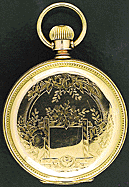
|
An
American beauty - a Waltham model 92 circa 1896; 18 size, 21 jewel, Railroad grade
pocketwatch with 14K solid gold hunting case, double sunk porcelain dial. Selling for
$1,495. |
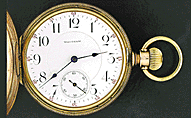
|
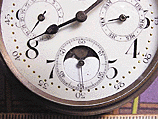
|
Photo
courtesy
www.miles-pocketwatches.com,
888-739-0124
Circa 1910 Swiss Moon Phase watch with date, day of week, seconds and moon phase, months. |
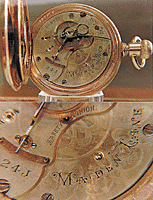
|
The
movement of a superb Seth Thomas. |
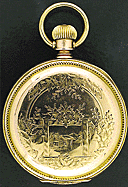
|
Photo
courtesy Eric Engh, www.oldwatch.com
800-750-6577. Poetry in movement. The back cover, above opens to reveal the inner workings
of a fine art. |
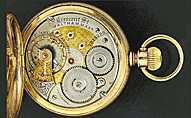
|
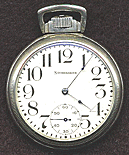
|
Above:
A Studebaker, about $495.
Below: Three little letters: the word "The" before "Studebaker" would
add $700 to $1000 to the price. |
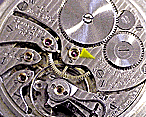
|
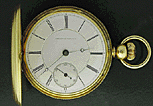
|
Waltham
circa 1861, 18 size Appleton Tracy, Model 59/18KW, 16 jewels, 18K, solid gold case, about
$6,500. |
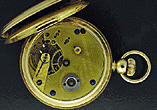
|
American Pocket Watch Companies |
(*Denotes
Railroad Grade/Approved Watch Makers)
*Aurora Manistee
*Ball Melrose
*Columbus New England
Dudley N.Y. Springfield
*Elgin N.Y. Standard
Fredonia *Peoria
*Hamilton Philadelphia
*Hampden J.P. Stevens
*Howard *Rockford
E.Howard *South Bend
*Illinois *Seth Thomas
Independent Tremont
Keystone Trenton
Lancaster *United States Watch Co., Marion
Manhattan United States Watch, Waltham
*Waltham (American Waltham) |
|